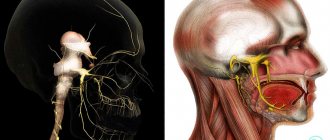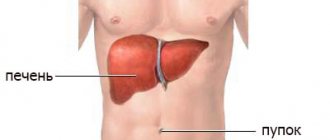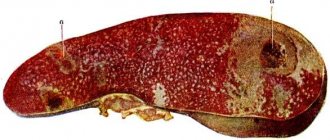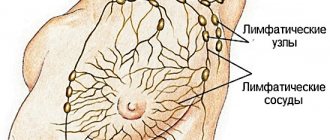Intercostal neuralgia is a lesion of the intercostal nerves, accompanied by intense pain. The pathology itself does not pose a threat to life, however, the symptoms of intercostal neuralgia can mask serious diseases, which include, first of all, cardiovascular pathologies, in particular myocardial infarction. In some cases, intercostal neuralgia indicates the presence of other diseases, for example, neoplasms of the spinal cord or chest organs, pleurisy.
Intercostal neuralgia is one of the most common diseases of the human nervous system.
The intercostal nerves contain both sensory and motor fibers, as well as sympathetic fibers. In the human body, there are 12 pairs of nerves in the intercostal region, each of which passes below the edge of the corresponding rib in the intercostal space as part of the neurovascular bundle. Intercostal nerves innervate the skin and muscles of the peritoneum, costal and diaphragmatic parts of the pleura, anterior abdominal wall, mammary gland, and chest. Neuralgia occurs when the roots of the intercostal nerves are compressed at their exit from the spine, usually as a result of muscle spasm.
Intercostal neuralgia occurs equally often in men and women. Susceptibility to the disease increases with age.
Synonyms: neuralgia of the intercostal nerves, thoracic radiculitis.
Causes of intercostal neuralgia and risk factors
The most common causes of neuralgia of the intercostal nerves are:
- osteochondrosis, spondylitis, ankylosing spondylitis and other diseases of the thoracic spine;
- tumors of the thoracic spinal cord;
- excessive physical activity;
- sudden unsuccessful movement;
- chest injury;
- forced awkward body position;
- general hypothermia of the body, hypothermia of the chest and back;
- pathologies of the upper gastrointestinal tract;
- herpetic infection.
In women, intercostal neuralgia can be caused by wearing tight underwear, as well as being underweight. In children and adolescents, intercostal neuralgia can occur during a period of intensive growth of the bone skeleton.
Intercostal neuralgia can occur due to excessive physical activity
The contributing factors are:
- metabolic disorders (diabetes mellitus);
- age-related changes in blood vessels;
- immunodeficiency;
- diseases of the nervous system;
- infectious and inflammatory diseases;
- intoxication of the body;
- uncomfortable workplace.
Forms of the disease
There are two main forms of intercostal neuralgia:
- radicular - caused by irritation of the roots of the spinal cord and is accompanied by pain in the thoracic region, can masquerade as cardiac pathology;
- reflex – occurs due to muscle tension in the intercostal spaces.
Intercostal neuralgia occurs equally often in men and women. Susceptibility to the disease increases with age.
Depending on the location, intercostal neuralgia is classified into unilateral and bilateral. The latter often occurs against the background of immunodeficiency, radiation sickness, herpes infection and a number of other diseases.
Is it possible to treat at home?
At home, intercostal neuralgia is not treated with medications. The following activities are carried out:
- local treatment - apply dry heat to the affected area (heating pad, warm sand, mustard plasters, pepper plaster);
- sleep on a hard, flat surface, wear a corset;
- They use traditional medicine - lotions, compresses, decoctions, tinctures. A mixture of glycerin and iodine has an effective effect. Lubricate your back with a tampon with this mixture (but do not rub it), put on cotton underwear and go to bed. The procedure is repeated every other day. Only 15 times.
Symptoms of intercostal neuralgia
The main symptom of intercostal neuralgia is paroxysmal piercing pain, which can be shooting, burning, stabbing, or resemble an electric shock. The pain intensifies when laughing, coughing, deep breathing, turning the body, raising the upper limbs. In addition, pain increases with palpation of the affected area and can become unbearable for the patient. The patient takes a forced body position (antalgic postures) to reduce or stop pain. The pain is long-lasting, often persisting day and night, although its intensity may vary.
The pain can have different localization. In women, against the background of hormonal changes during menopause and/or postmenopause, pain is often noted in the area of the projection of the heart, pain can radiate to the mammary gland. In men, pain is more often localized at the level of the lower ribs, on the left side of the chest. Depending on the location of the lesion, the pain may radiate to the heart, scapula, and epigastrium. When pain is localized along one or two intercostal nerves, it can acquire a girdling character.
In women, pain from intercostal neuralgia can radiate to the mammary gland
A characteristic sign of intercostal neuralgia is that pain does not decrease at night. In the early stages of the disease, pain in the chest may be less intense, manifesting itself in the form of tingling, but increase with the progression of the pathology. Pain with intercostal neuralgia can be either unilateral or bilateral. During the first few days from the onset of the pathological condition, attacks of intercostal neuralgia can lead to sleep disturbances (including insomnia) and a deterioration in the patient’s general condition.
In children, intercostal neuralgia manifests itself as severe pain in the affected area and is accompanied by convulsions, sleep disturbances, increased excitability, and speech disorders.
The clinical picture of the disease may include:
- muscle spasms in the affected area;
- numbness of the affected area;
- increased sweating (hyperhidrosis);
- pallor or redness of the skin;
- feeling of crawling sensations;
- shortness of breath (due to incomplete breathing during attacks of pain); etc.
Signs of intercostal neuralgia, which is caused by a herpetic viral infection, are a rash on the skin and itching of the skin that occurs even before the rash appears. Skin rashes are pink spots that transform into vesicles and dry out. The rash is localized on the skin of the intercostal space. Temporary hyperpigmentation of the skin is observed in place of the rash elements during the period of convalescence.
Traditional methods
For intercostal neuropathy, rubbing with tincture of valerian or birch buds has a fairly good result. However, it is better not to apply alcohol compresses for a long time, as this can lead to burns.
Warming up helps eliminate the pain, but the thermal effect should not be direct, therefore, you just need to wrap yourself in a knitted woolen item or a downy scarf. If you heat the affected area too much, the pain will go away only for a while, and such an effect will only increase the swelling. Baths with sage and sea salt help relieve tension and reduce pain.
To prevent the disease from becoming chronic, it is necessary to exclude exposure to harmful concomitant factors, in particular, such as physical overexertion, as well as alcohol abuse.
Diagnosis of intercostal neuralgia
The primary diagnosis of intercostal neuralgia is carried out on the basis of complaints and anamnesis, as well as an objective examination of the patient. Often the data obtained is sufficient to diagnose the disease. In complex diagnostic cases, as well as for the purpose of differential diagnosis with other pathologies that have similar manifestations, an additional examination is carried out, which, depending on the indications, includes:
- magnetic resonance and computed tomography (to exclude neoplasms, hernia);
- X-ray examination of the chest and spine in direct, lateral and oblique projections;
- electroneurography (if the consequences of injuries are suspected);
- electrocardiography (to exclude diseases of the cardiovascular system);
- ultrasonography;
- contrasting discography;
- gastroscopy (to exclude pathologies of the gastrointestinal tract);
- general and biochemical blood test;
- general urine analysis;
- serological blood test; etc.
Diagnosis of intercostal neuralgia involves an x-ray examination
The information content of computed tomography increases when performed in conjunction with an X-ray contrast examination of the spinal cord cerebrospinal fluid tract (myelography).
In some cases, intercostal neuralgia indicates the presence of other diseases, for example, neoplasms of the spinal cord or chest organs, pleurisy.
It is possible to identify pathology at an early stage, as well as monitor the effectiveness of treatment using electrospondylography. The method allows you to assess the condition of the spine and determine the extent of damage.
Differential diagnosis of intercostal neuralgia with other diseases is necessary:
- cardiovascular pathologies (angina pectoris, coronary heart disease, myocardial infarction);
- intervertebral hernia;
- thoracic radiculitis;
- pleurisy;
- lung cancer and other chest tumors;
- diseases of the gastrointestinal tract (gastritis, acute pancreatitis, gastric ulcer);
- atypical pneumonia;
- renal colic; and etc.
Treatment of intercostal neuralgia
Patients with intercostal neuralgia are prescribed bed rest for a period of several days to several weeks.
Acute pain syndrome accompanying intercostal neuralgia is relieved by parenteral administration of analgesics. If this is not enough, they resort to novocaine blockade of the intercostal nerves. After the pain intensity decreases, the patient is transferred to parenteral painkillers.
In case of severe pain, novocaine blockade is performed
Treatment of intercostal neuralgia is complex. For increased muscle tone, centrally acting muscle relaxants are used. Swelling in the affected area is eliminated with the help of diuretics, as well as venotonics. In order to improve the functions of the nerve involved in the pathological process, parenteral use of ascorbic acid and B vitamins is indicated. Non-steroidal anti-inflammatory drugs are used according to indications (for patients with heartburn, gastritis or peptic ulcers, their prescription is supplemented with drugs from the group of organotropic gastrointestinal drugs), sedatives, antidepressants, vitamin complexes.
In the case of the development of intercostal neuralgia against the background of a herpetic infection, antiviral drugs and antihistamines are prescribed. Treatment is complemented by local use of antiherpetic drugs in the form of ointments.
In women, intercostal neuralgia can be caused by wearing tight underwear, as well as being underweight. In children and adolescents, intercostal neuralgia can occur during a period of intensive growth of the bone skeleton.
As a complement to the main treatment of intercostal neuralgia, mustard plasters, compresses, and anti-inflammatory drugs in the form of gels and ointments can be used in the area where the pain is localized. The positive side of using topical medications for intercostal neuralgia is that these drugs do not pass through the liver, therefore, their concentration does not decrease.
It is necessary to exclude stress on the body, stress, and alcohol.
After acute symptoms subside, physical therapy is prescribed to accelerate remission and prevent relapses. The therapeutic effect is provided by the following methods:
- ultraviolet irradiation of the chest;
- UHF therapy;
- electrophoresis of drugs;
- darsonvalization;
- mud therapy, paraffin therapy.
Physiotherapy and manual therapy are used after relief of acute symptoms of intercostal neuralgia
In case of intercostal neuralgia due to displacement of the vertebrae or osteochondrosis, gentle manual therapy or traction of the spinal column can be performed. For intercostal neuralgia that has developed against the background of spinal pathologies, the main treatment is recommended to be supplemented with physical therapy, including a set of restorative exercises.
For intercostal neuralgia caused by a tumor, treatment is carried out in the oncology department.
General therapeutic techniques
If there is severe pain, the patient is prescribed strict bed rest with staying on a hard surface and with maximum immobilization. To reduce pain, physiotherapeutic techniques are recommended, in particular, such as:
- UHF;
- reflexology;
- iontophoresis;
- vacuum therapy;
- acupuncture;
- pharmacopuncture;
- magnetotherapy.
In combination with therapeutic measures, local treatment is important, in particular the use of creams and ointments with warming, analgesic and anti-inflammatory effects. Products containing insect poisons, as well as pepper plaster, have proven themselves to be effective.
Possible complications and consequences
In the absence of adequate treatment, intercostal neuralgia can have complications:
- circulatory disorders with subsequent development of pathologies of muscles and internal organs;
- scoliosis;
- chronic pain syndrome;
- exacerbation of chronic diseases of the digestive system;
- increased blood pressure, hypertensive crisis;
- transient ischemic attack, stroke;
- angina attack accompanied by intense pain; and etc.
Drug therapy
When treating intercostal neuropathy, it is necessary to eliminate the pain syndrome and pathology that provoked compression or inflammation of the nerve endings. To reduce pain, anti-inflammatory drugs are prescribed, in particular, such as:
- "Riofecoxib";
- "Diclofenac";
- Meloxicam.
Painkillers will help suppress inflammation and eliminate discomfort. In such cases, the drugs are used in the form of an injection. To eliminate muscle spasm, the use of muscle relaxants is indicated, in particular, such as:
- "Sirdalud";
- "Mydocalm";
- "Tolperil."
If necessary, treatment is supplemented by taking sedatives. Usually, herbal-based medicines are used to restore the nervous system, in particular, such as:
- "Persen";
- "Novo-Passit";
- "Sedasen."
To reduce the intensity of general symptoms, it is recommended to treat the affected area with ointments or gels with an anti-inflammatory effect, in particular, such as:
- "Capsicam";
- "Finalgon";
- "Menovazin".
If compression of nerve fibers is caused by intervertebral hernia or tumors, then surgical intervention is prescribed. For herpes zoster, the use of vitamin complexes and antiviral drugs of local and systemic action is indicated.
Prevention
Specific prevention of neuralgia of the intercostal nerves has not been developed; general strengthening measures will help prevent the development of pathology. Recommended:
- a healthy lifestyle, including regular moderate physical activity and a rational, balanced diet;
- hardening of the body;
- timely treatment of spinal diseases, chest injuries, pathologies of internal organs;
- measures to help prevent spinal curvature or treat an existing curvature;
- avoiding hypothermia;
- work in comfortable conditions, with prolonged forced body positions, take breaks for a short warm-up.
Video from YouTube on the topic of the article:
general description
Intercostal neuropathy (G58.0) is a tunnel neuropathy caused by compression of the intercostal nerves. Prevalence of intercostal neuropathy: 5–12 cases per 100 thousand people. More common in people over 50 years of age. The lesion is characteristically unilateral. Predisposing factors are hypothermia, physical overload, back or chest injuries, and spinal surgery.








